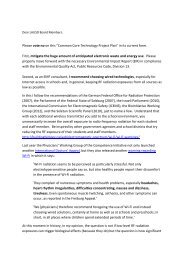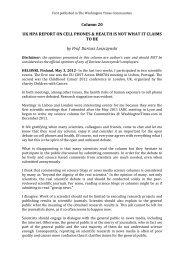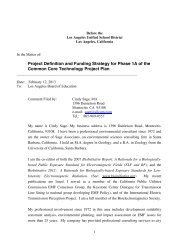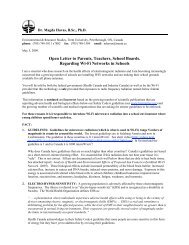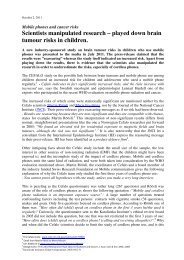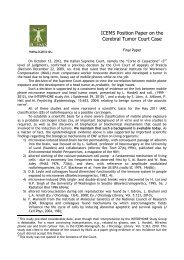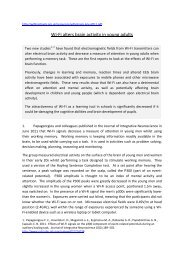Epidemiological Evidence for a Health Risk from Mobile Phone ...
Epidemiological Evidence for a Health Risk from Mobile Phone ...
Epidemiological Evidence for a Health Risk from Mobile Phone ...
You also want an ePaper? Increase the reach of your titles
YUMPU automatically turns print PDFs into web optimized ePapers that Google loves.
CONCLUSIONS<br />
Despite variations in the design, size and quality of<br />
these studies as summarized in Table 1, it is the consistency<br />
of the base-station epidemiological literature<br />
<strong>from</strong> several countries that we find striking. In<br />
particular, the increased prevalence of adverse neurobehavioral<br />
symptoms or cancer in populations<br />
living at distances < 500 meters <strong>from</strong> base stations<br />
found in 80% of the available studies. It should be<br />
pointed out that the overall findings of health problems<br />
associated with base stations might be based on<br />
methodological weaknesses, especially since exposure<br />
to RF electromagnetic radiation was not always<br />
measured.<br />
There are some proposed mechanisms via which<br />
low-intensity EMF might affect animal and human<br />
health, 16,17 but full comprehensive mechanisms still<br />
remain to be determined. 18,19 Despite this, the accumulating<br />
epidemiological literature pertaining to the<br />
health effects of mobile phones 13,20 and their base stations<br />
(Table 1) suggests that previous exposure standards<br />
based on the thermal effects of EMF should no<br />
longer be regarded as tenable. In August 2007, an<br />
international working group of scientists, researchers,<br />
and public health policy professionals (the BioInitiative<br />
Working Group) released its report on EMF and<br />
health. 21 It raised evidence-based concerns about the<br />
safety of existing public limits that regulate how much<br />
EMF is allowable <strong>from</strong> power lines, cellular phones,<br />
base stations, and many other sources of EMF exposure<br />
in daily life. The BioInitiative Report 21 provided<br />
detailed scientific in<strong>for</strong>mation on health impacts<br />
when people were exposed to electromagnetic radiation<br />
hundreds or even thousands of times below limits<br />
currently established by the FCC and International<br />
Commission <strong>for</strong> Non-Ionizing Radiation Protection in<br />
Europe (ICNIRP). The authors reviewed more than<br />
2000 scientific studies and reviews, and have concluded<br />
that: (1) the existing public safety limits are<br />
inadequate to protect public health; and (2) <strong>from</strong> a<br />
public health policy standpoint, new public safety<br />
limits and limits on further deployment of risky technologies<br />
are warranted based on the total weight of<br />
evidence. 21 A precautionary limit of 1 mW/m 2 (0.1<br />
microW/cm 2 or 0.614 V/m) was suggested in Section<br />
17 of the BioInitiative Report to be adopted <strong>for</strong> outdoor,<br />
cumulative RF exposure. 21 This limit is a cautious<br />
approximation based on the results of several<br />
human RF-EMF studies in which no substantial<br />
adverse effects on well being were found at low exposures<br />
akin to power densities of less than 0.5 – 1<br />
mW/m 2 . 2,5,22–26 RF-EMF exposure at distances > 500 m<br />
<strong>from</strong> the types of mobile phone base stations reviewed<br />
herein should fall below the precautionary limit of<br />
0.614 V/m.<br />
References<br />
1. Khurana VG, Teo C, Kundi M, Hardell L, Carlberg M. Cell<br />
phones and brain tumors: A review including the long-term epidemiologic<br />
data. Surg Neurol. 2009;72:205-214.<br />
2. Navarro EA, Segura J, Portolés M, Gómez-Perretta C. The<br />
microwave syndrome: A preliminary study in Spain. Electromag<br />
Biol Med. 2003;22:161–169.<br />
3. Santini R, Santini P, Le Ruz P, Danze JM, Seigne M. Survey study<br />
of people living in the vicinity of cellular phone base stations.<br />
Electromag Biol Med. 2003;22:41-49.<br />
4. Gadzicka E, Bortkiewicz A, Zmyslony M, Szymczak W,<br />
Szyjkowska A. Assessment of subjective complaints reported by<br />
people living near mobile phone base stations [Abstract]. Biuletyn<br />
PTZE Warszawa. 2006;14:23-26.<br />
5. Hutter HP, Moshammer H, Wallner P, Kundi M. Subjective<br />
symptoms, sleeping problems, and cognitive per<strong>for</strong>mance in<br />
subjects living near mobile phone base stations. Occup Environ<br />
Med. 2006;63:307-313.<br />
6. Abdel-Rassoul G, El-Fateh OA, Salem MA, Michael A, Farahat F,<br />
El-Batanouny M, Salem E. Neurobehavioral effects among<br />
inhabitants around mobile phone base stations. Neurotoxicology.<br />
2007;28:434-440.<br />
7. Eger H, Hagen KU, Lucas B, Vogel P, Voit H. Einfluss der raumlichen<br />
nahe von mobilfunksendeanlagen auf die krebsinzidenz.<br />
[The influence of being physically near to a cell phone transmission<br />
mast on the incidence of cancer]. Umwelt-Medizin-<br />
Gesellschaft. 2004;17:326-332.<br />
8. Wolf R, Wolf D. Increased incidence of cancer near a cell-phone<br />
transmitter station. Int J Cancer Prev. 2004;1:123-128.<br />
9. Meyer M, Gartig-Daugs A, Radespiel-Troger M. Cellular telephone<br />
relay stations and cancer incidence. Umweltmed Forsch<br />
Prax. 2006;11:89-97.<br />
10. Blettner M, Schlehofer B, Breckenkamp J, Kowall B, Schmiedel<br />
S, Reis U, Potthoff P, Schüz J, Berg-Beckhoff G. <strong>Mobile</strong> phone<br />
base stations and adverse health effects: Phase 1 of a populationbased,<br />
cross-sectional study in Germany. Occup Environ Med.<br />
2009;66:118-123.<br />
11. Berg-Beckhoff G, Blettner M, Kowall B, Breckenkamp J,<br />
Schlehofer B, Schmiedel S, Bornkessel C, Reis U, Potthoff P,<br />
Schüz J. <strong>Mobile</strong> phone base stations and adverse health<br />
effects: Phase 2 of a cross-sectional study with measured radio<br />
frequency electromagnetic fields. Occup Environ Med. 2009;<br />
66:124-130.<br />
12. Neubauer G, Feychting M, Hamnerius Y, Kheifets L, Kuster N,<br />
Ruiz I, Schüz J, Uberbacher R, Wiart J, Röösli M. Feasibility of<br />
future epidemiological studies on possible health effects of<br />
mobile phone base stations. Bioelectromagnetics. 2007;28:224-<br />
230.<br />
13. Khan MM. Adverse effects of excessive mobile phone us. Int J<br />
Occup Environ <strong>Health</strong>. 2008;21:289-293.<br />
14. Söderqvist F, Carlberg M, Hardell L. Use of wireless telephones<br />
and self-reported health symptoms: A population-based study<br />
among Swedish adolescents aged 15-19 years. Environ <strong>Health</strong><br />
2008;7:18.<br />
15. Hardell L, Sage C. Biological effects <strong>from</strong> electromagnetic field<br />
exposure and public exposure standards. Biomed Pharmacother.<br />
2008;62:104-109.<br />
16. Sal<strong>for</strong>d LG, Nittby H, Brun A, Grafström G, Malmgren L, Sommarin<br />
M, Eberhardt J, Widegren B, Persson BRR. The mammalian<br />
brain in the electromagnetic fields designed by man with<br />
special reference to blood-brain barrier function, neuronal<br />
damage and possible physical mechanisms. Prog Theor Phys<br />
Suppl. 2008;173:283-309.<br />
17. Sheppard AR, Swicord ML, Balzano Q. Quantitative evaluations<br />
of mechanisms of radiofrequency interactions with biological<br />
molecules and processes. <strong>Health</strong> Phys. 2008;95:365-396.<br />
18. Khurana VG. Cell phone and DNA story overlooked studies. Science.<br />
2008;322:1325.<br />
19. Yang Y, Jin X, Yan C, Tian Y, Tang J, Shen X. Case-only study of<br />
interactions between DNA repair genes (hMLH1, APEX1,<br />
MGMT, XRCC1 and XPD) and low-frequency electromagnetic<br />
fields in childhood acute leukemia. Leuk Lymphoma. 2008;<br />
49:2344-2350.<br />
266 • Khurana et al. www.ijoeh.com • INT J OCCUP ENVIRON HEALTH



